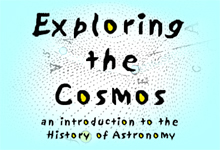

Department of History
University of California, Irvine
Instructor: Dr. Barbara J. Becker
![]()
Lecture 19. The Martian Canals Controversy.
![]()
Early Telescopic Observations of Mars |
| The advent of the telescope in the seventeenth century revealed the planet Mars as a tiny pale disk. It was a dull and uninspiring sight compared to the drama offered by Jupiter and its satellites, Venus's phases, or Saturn's curious appendages. Over the years, as both instruments and their employers grew in observational capability, Mars became a popular, if somewhat confounding, target. The drawings of individuals who recorded their impressions of the planet's surface testify to the rich variety in visual perception and interpretation among those who trained their telescopes on Earth's intriguing neighbor. Italian lawyer, Francisco Fontana (c. 1580-1656) was the first to produce drawings of Mars based on his telescopic observations. 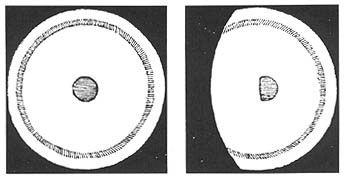
Fontana made the drawing on the left in 1636, the one at right on 24 August 1638. The disk in Fontana's 1636 drawing appears perfectly circular with a dark spot in the center that he described as looking like a "very black pill." Fontana may have thought this feature represented a spot on the surface of the planet. He later drew a similar black spot on Venus and even used the same word -- pilula -- to describe it.
Sketches of Venus drawn by Fontana in November 1645 (left) and January 1646 (right) The planetary spots Fontana "saw" on Mars and Venus were probably produced by an optical defect in his telescope. |
Dutch physicist and mathematician Christian Huygens (1629-95) was disappointed to find what looked like a featureless surface when he viewed Mars in 1656. But when he looked again in November 1659, he saw a prominent and irregularly shaped dark area. As the evening wore on, he noticed a change in the position of that dark area. Comparing these observations with what he saw when he looked at Mars a few days later led Huygens to conclude that Mars, like Earth, makes one complete rotation every 24 hours.
Huygens's sketch of Mars on 28 November 1659 |
Giovanni Domenico Cassini (1625-1712) at the Panzano Observatory in Bologna made several observations of Mars in the spring of 1666. His drawings are the first to show bright white patches that, to modern eyes, vaguely resemble icy polar caps. Cassini determined that Mars rotated once every 24 hours 40 minutes, an improvement over Huygens' estimate. |
In London, Robert Hooke (1635-1703) also observed Mars in the spring of 1666. Although he imagined that he "saw Spots" on Mars's surface, the air was so unsteady that he confessed he "could not conclude upon any thing."
Robert Hooke's drawings of Mars (1666) |
Christian Huygens observed Mars again in August 1672. This time his sketch included a dark pattern recognizable to modern observers as Syrtis Major. He also marked off a feature that appears to represent the ice cap at the southern pole.
|
We should not be too critical of these early observers' drawings. Mars is a small planet, just twice the size of our Moon. Even at its closest approach, the red planet is over 140 times farther from Earth than the Moon.
The relative sizes of the full Moon (left) and Mars at its closest approach (right) as seen on the sky from Earth. Earthbound observers would have to wait until telescopes were greatly improved before they could see any detail on Mars's surface. |
William Herschel (1738-1822) had many opportunities to observe Mars in 1783. With the aid of his unparalleled reflecting telescopes, Herschel noted and measured Mars's axial tilt. He further improved the estimate of the length of Mars's day and he looked for signs of a martian atmosphere. He also identified what he believed were polar ice caps on the planet.
In 1784, Herschel reported to the Royal Society:
|
Herschel's observations were an inspiration to others, notably German lawyer, Johann Hieronymus Schroeter (1745-1816). Schroeter launched his serious observing career after hearing about Herschel's discovery of the planet Uranus in 1781. He built telescopes like Herschel's using mirrors that Herschel had made himself. With these fine instruments, Schroeter devoted nearly all his time to observing and mapping features on the Moon and planets, including Mars.
Drawings of Mars based on observations Schroeter made on 1 and 2 November 1800. Schroeter -- apparently impressed by the great variety of markings he saw on the surface of Mars -- concluded they were impermanent phenomena, possibly clouds. |
Most other observers assumed the markings on Mars were permanent geological features. In 1830, two individuals, banker Wilhelm Beer (1797-1850) and schoolteacher Johann Heinrich Maedler (1794-1874), began producing detailed drawings of the martian surface based on their collaborative observations.
They identified several easily identified features on Mars's surface and began transferring the outlines of those features onto a global coordinate system in 1831.
In 1840, after observing Mars for several years, Beer and Maedler produced a full map of Mars.
Prominent features seen in Mars's north and south polar regions plotted by Beer and Maedler (1840) |
Observations of Mars were among the first to be recorded by amateur astronomer, William Huggins (1824-1910) in his new observatory notebook.
These drawings show that Huggins, like most observers, came to each observation with an expectation of what he would see. Of special interest are his representations of the planet's dark surface markings. Those he saw on 24 April at ten o'clock seem to have shown up again when he viewed Mars at 8:30 on 28 April. His sketch from 2 June suggests he witnessed yet another return of the same markings. But, on the evening of 28 April, that hemisphere did not rotate into view until after midnight, about four hours after he observed it. Perhaps Huggins did not schedule his observations to coincide with martian rotations. Perhaps he simply observed when he had an opportunity. If that is the case, the near-identical appearance of his drawings for 24 and 28 April is extraordinary. Even though the face of Mars visible on 24 April had not fully rotated into view when he looked again on 28 April, he represented it as if it had. If he wanted to observe when the 24 April hemisphere was visible again, why did he look at 8:30 in the evening? The answer could lie in a simple, and inadvertent, mistake. Perhaps, in planning for his observation on 28 April, he adjusted the time in the wrong direction: instead of adding the thirty-nine minute difference to Earth's twenty-four hour clock in order to stay in sync with Mars's rotation, he subtracted it giving him an optimal viewing time around 7:30 p. m. The side of Mars Huggins viewed at 10 o'clock on 2 June 1856 would have been almost the same as that on 24 April. But by June, the distance between Mars and Earth had increased leaving the red planet looking smaller to Earth-bound observers than it had appeared in April. Also, the fully-illuminated face of Mars was not longer visible from Earth in June, so it would have appeared slightly gibbous. Compare Huggins's sketches with those of his colleague, veteran observer, Warren De la Rue (1815-1889):
Drawings of Mars by Warren De la Rue from observations made two hours apart on 20 April 1856 |
In 1867, astronomer and popular science writer Richard Proctor (1837-1888) published a map of Mars based on drawings by English observer, William Rutter Dawes (1799-1868). Proctor named the planet's features -- assumed to be bodies of water and large land masses -- after well-known scientific figures -- like Hooke, Cassini and Herschel -- who had contributed to contemporary knowledge of the planet: |
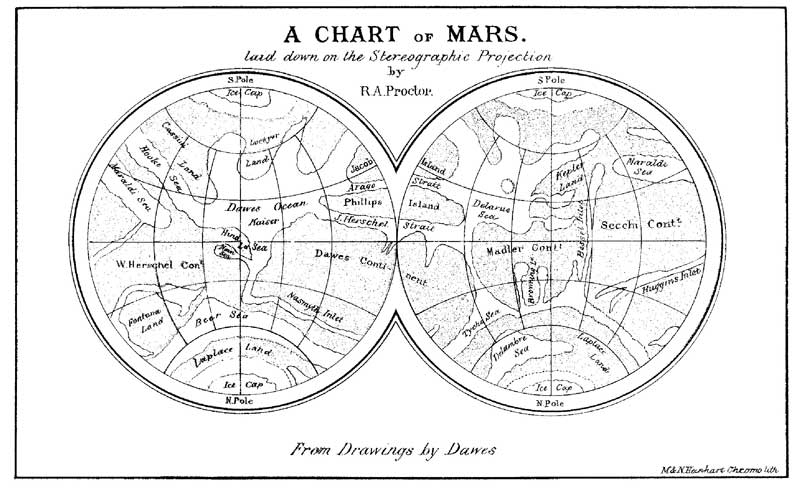
| Giovanni Virginio Schiaparelli (1835-1910) created a detailed map based on careful observations of Mars from 1877 to 1886. Camille Flammarion published the version of Schiaparelli's map shown belowed in La Planète Mars (1892). |
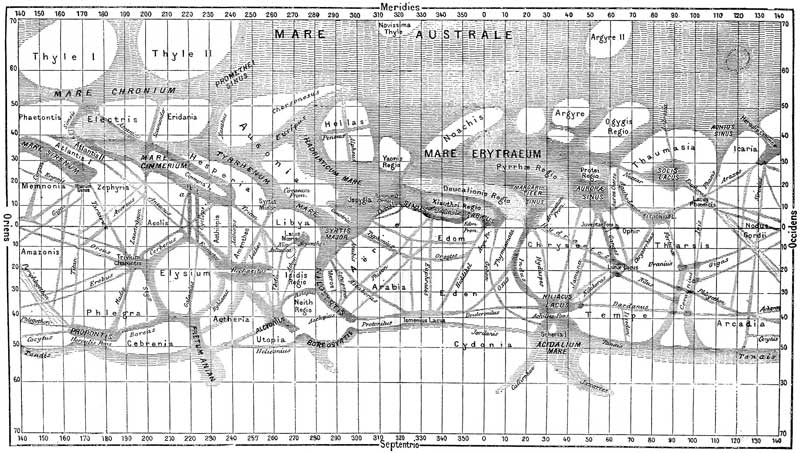
Schiaparelli renamed the markings based on mythical and historical places here on Earth, like Arabia, Eden and Elysium. He used the term canali, first introduced by astronomer Angelo Secchi (1818-1878), to describe the long thin dark lines that crisscrossed the planet's northern hemisphere. Canali can be translated as "channels" or "canals". Schiaparelli considered all the features on Mars to be natural formations, but after seeing Sciaparelli's map, the idea that the canali could be engineered waterways struck a chord with some observers.
|
Percival Lowell and the Canals
of Mars |
|
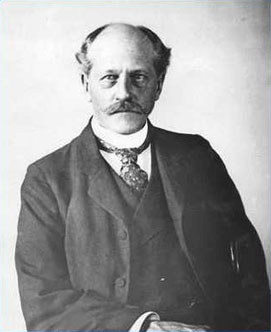
Percival Lowell (1855-1916) Percival Lowell was born in 1855 to a distinguished Boston family. When he was just nine years old, his family traveled to Europe and young Percival attended school in France and became fluent in the French language. At age 21, he graduated from Harvard University with a degree in mathematics. Lowell worked for six years managing the operation of his family's cotton mills and utility companies. Unhappy with the life of a businessman, he left the family business to experience the adventure of world travel. Lowell worked for several years as a diplomat, traveling throughout the Far East. He mastered the Japanese language and recorded his experiences in a number of books. When he returned to the United States in 1893, Lowell decided to pursue his longtime interest in astronomy. He had become fascinated with the observations of Mars made by a prominent Italian astronomer, Giovanni Virginio Schiaparelli. Schiaparelli claimed to have seen dark lines crossing the surface of Mars, lines which he called canali, or canals. In 1894, Percival Lowell located a place in the United States where the atmosphere was steadiest -- Flagstaff, Arizona. He built an observatory to view Mars, making sure it was ready in time to view the planet when it would once again be closest to Earth. Lowell had no trouble seeing a network of canals on Mars, just like those Schiaparelli had described. He began mapping and naming these lines. This project occupied him until his death in 1916. Under Lowell's direction, the Lowell Observatory became known worldwide. It is still in operation today. In his book Mars (1895), Lowell wrote enthusiastically about Schiaparelli's canali:
|
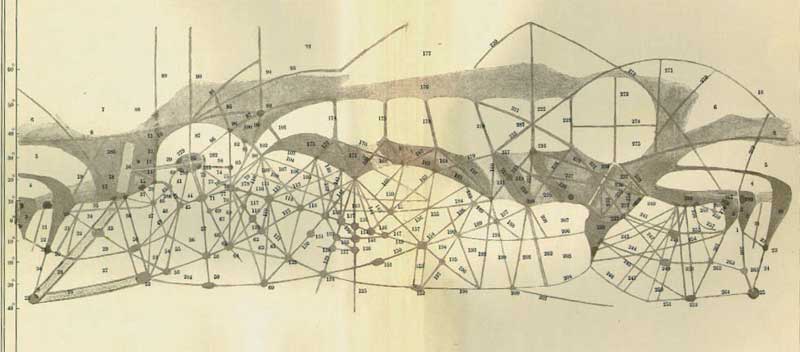
Map of Mars from Mars (1895) by Percival Lowell
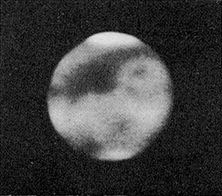
Photograph of Mars (above) by E. C. Slipher (1907) at the Lowell Observatory showing the same face of the planet depicted in Lowell's drawing (right) |

Drawing of Mars by Percival Lowell (1895) |
| Soon, it seemed that Lowell was finding planetary lines everywhere! | |
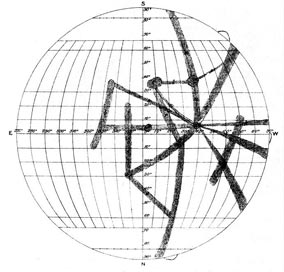 Lines on Venus |
|
In 1903, J. E. Evans and Walter Maunder, an astronomer at the Greenwich Observatory, conducted an experiment to test whether the canals of Mars could be simply a result of subjective human perception. In their experiment, Evans and Maunder created a 6.3-inch diagram (shown on the left in the illustration below) based on a drawing of Mars.
|
They placed this illustration in front of a group of schoolboys. The boys, arranged in rows at different distances from the picture, were asked to sketch what they saw. Nearly all the boys' drawings showed canal-like networks of intersecting lines (similar to the sketch seen on the right in the illustration above) even though no such features existed in the original diagram.
|
Lowell: Maverick or Innovator? |
Some researchers, like Lowell, who work on the cutting edge of science:
Are these researchers mavericks, or innovators? |
|